Roast leg of lamb is a timeless dish that never fails to impress, whether you’re preparing it for a holiday feast or a cozy family dinner. The blackened honey Dijon crust takes it to the next level, adding a perfect balance of sweetness, tanginess, and savory richness. This guide will walk you through everything from selecting the right cut to perfecting the crust and enhancing flavors with the right seasonings.
Now, let’s move on and explore how to select the perfect lamb leg and the essential ingredients that bring this recipe to life.
Selecting the Best Leg of Lamb for Roasting
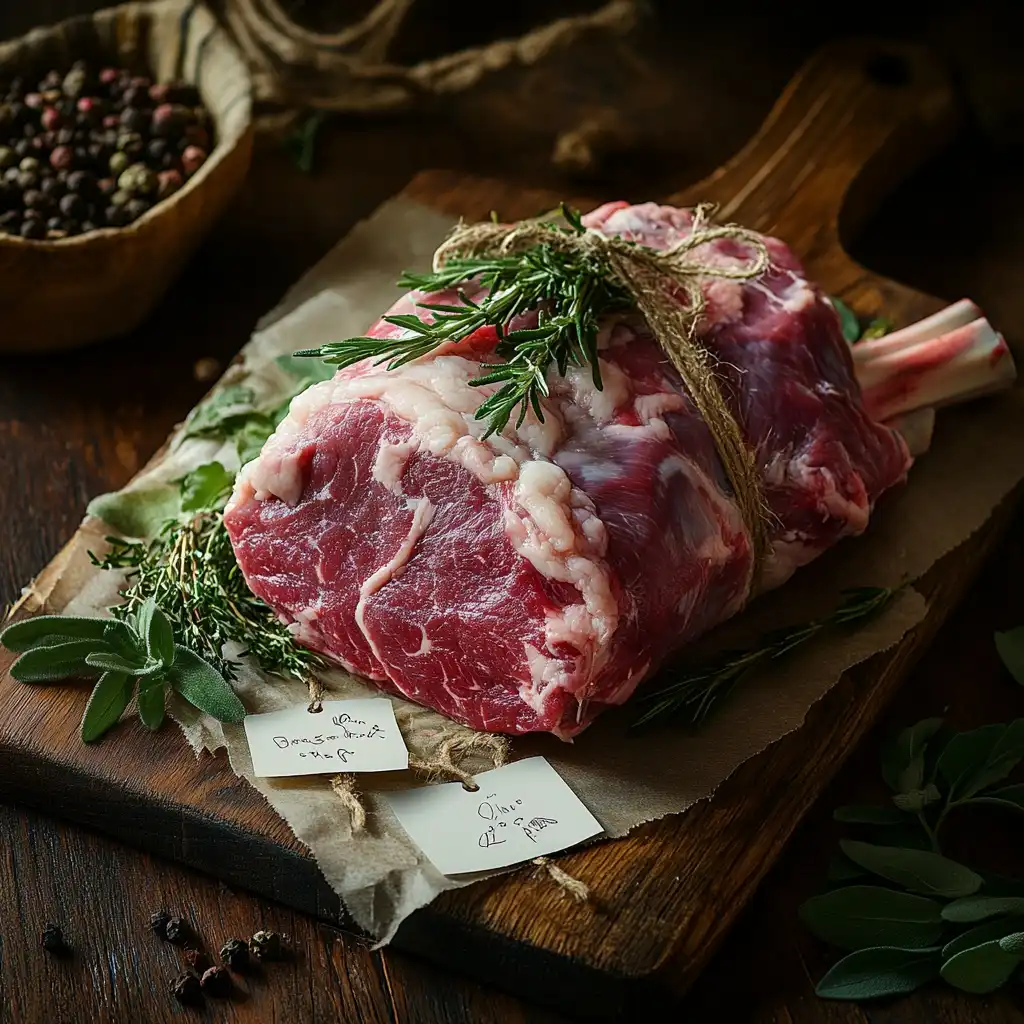
The secret to a mouthwatering Roast Leg of Lamb with Blackened Honey Dijon Crust starts with choosing the right cut. Not all lamb legs are created equal, and selecting a high-quality piece will make all the difference in tenderness and flavor.
Bone-In vs. Boneless Roasted Leg of Lamb: What’s Best?
Both bone-in and boneless lamb legs have their merits, and the choice depends on your preference:
- Bone-in lamb leg delivers richer flavor and more juiciness since the bone helps retain moisture. It also makes for a stunning presentation.
- Boneless lamb leg is easier to carve and cooks slightly faster. If convenience is your priority, this is a great option.
For the best balance of flavor and tenderness, a semi-boneless leg of lamb—with the shank bone removed but the femur intact—is a perfect compromise.
Choosing the Right Size Based on Guest Count
Plan on about ½ to ¾ pound per person for bone-in lamb and ⅓ to ½ pound per person for boneless. A 5-pound leg serves 6-8 people, making it ideal for gatherings.
How to Pick the Juiciest Lamb for a Perfect Blackened Crust
Look for lamb with:
✔ Pale pink to deep red color (avoid meat that looks brown or grayish).
✔ Firm, white fat marbling, which keeps the meat moist.
✔ A mild, fresh scent—a strong odor means it’s past its prime.
Choosing the best cut ensures your blackened honey Dijon crust will sit atop juicy, tender lamb rather than dry or tough meat.
For expert tips on selecting high-quality lamb, check out the USDA Guidelines for Meat Selection.
Essential Ingredients for a Flavorful Honey Mustard Lamb Roast
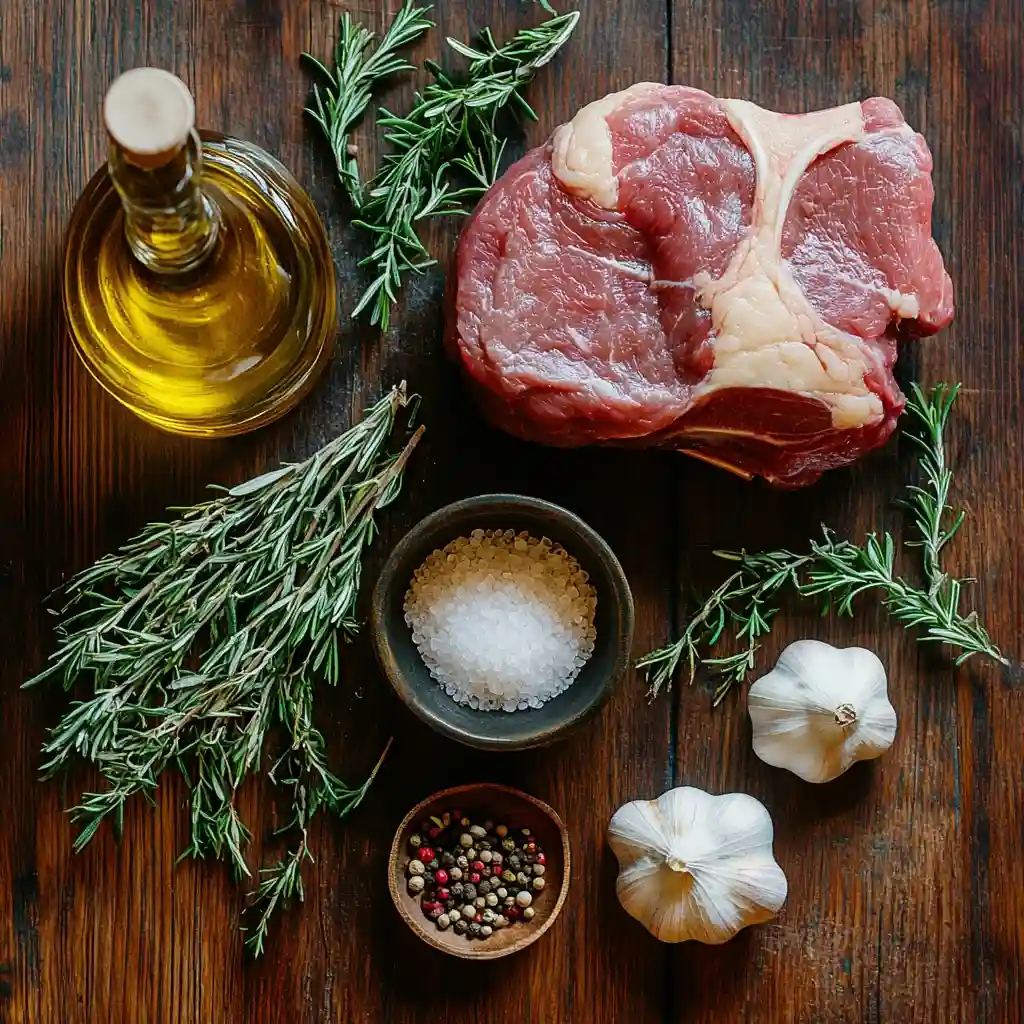
A great recipe starts with great ingredients, and this Roast Leg of Lamb with Blackened Honey Dijon Crust is no exception. Each element plays a crucial role in achieving that perfect blend of crispiness, depth, and juiciness.
Why Honey Dijon and Garlic Create the Ultimate Crust
Honey Dijon mustard is the game-changer in this recipe. It provides:
- Tangy sharpness from the Dijon, which cuts through the richness of the lamb.
- Natural caramelization, helping to form that irresistible crispy crust.
- A sticky base that helps herbs and spices adhere better.
Herbs and Spices That Make the Best Blackened Roast Lamb
Lamb is bold in flavor, so it pairs well with robust herbs:
✔ Garlic—Enhances the meat’s natural richness and gives a deep umami punch.
✔ Rosemary—Adds an earthy, slightly piney note.
✔ Thyme & Oregano—Contribute warmth and a Mediterranean aroma.
A combination of these herbs mixed with honey Dijon mustard creates a fragrant, well-balanced crust that seals in moisture and intensifies flavor.
Supporting Ingredients: Olive Oil, Kosher Salt, and Fresh Black Pepper
- Olive oil ensures even cooking and enhances the herb rub.
- Kosher salt draws out the natural juices and tenderizes the meat.
- Fresh black pepper adds a touch of heat and complexity.
With these carefully chosen ingredients, your Roast Leg of Lamb with Blackened Honey Dijon Crust will be bursting with deep, rich flavors and a beautifully caramelized crust.
Preparing the Leg of Lamb for Roasting
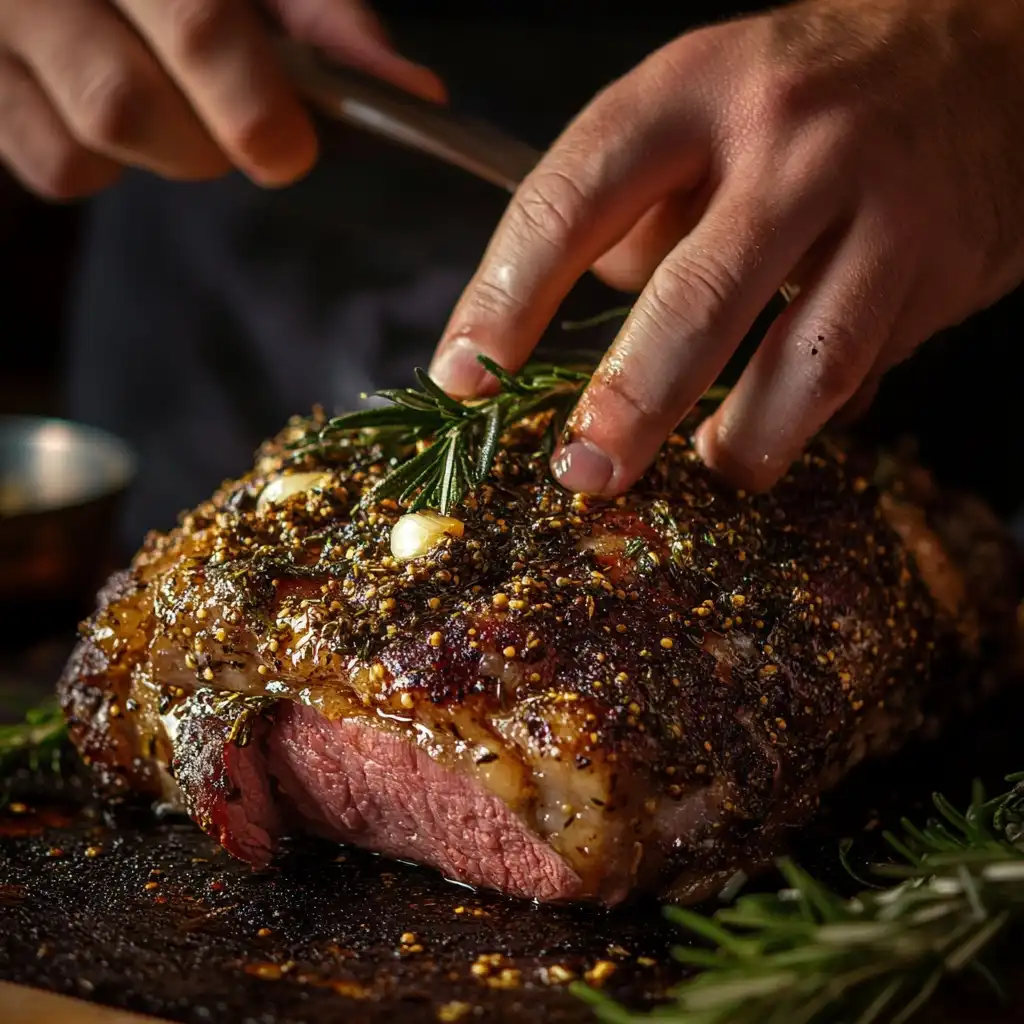
Before roasting, proper preparation ensures your Roast Leg of Lamb with Blackened Honey Dijon Crust turns out juicy and flavorful. From trimming excess fat to seasoning, every step matters.
How to Properly Trim and Clean the Meat
Lamb has a layer of fat that adds flavor but too much can lead to greasiness. Follow these steps:
✔ Use a sharp knife to trim excess fat, leaving about ¼ inch for moisture.
✔ Remove silver skin, a tough membrane that won’t break down during cooking.
✔ Pat the lamb dry with paper towels for better seasoning adhesion.
Marinating for Maximum Flavor Infusion
A flavor-packed marinade enhances the lamb’s taste and tenderness. Combine:
- Honey Dijon mustard (for sweetness and tang)
- Garlic (for depth and boldness)
- Olive oil (to help herbs stick)
- Rosemary, thyme, and oregano (to complement the richness)
Rub this all over the lamb, ensuring it reaches every nook and cranny. Let it sit at least 2 hours or overnight for the best flavor.
Making Deep Cuts for Garlic Insertion
For even more flavor, use a sharp knife to make small incisions all over the lamb. Insert thin slivers of garlic into these cuts this infuses the meat with garlicky goodness as it roasts.
With proper preparation, your lamb will soak in all the delicious flavors, ensuring a tender and well-seasoned bite.
The Science Behind the Blackened Crust
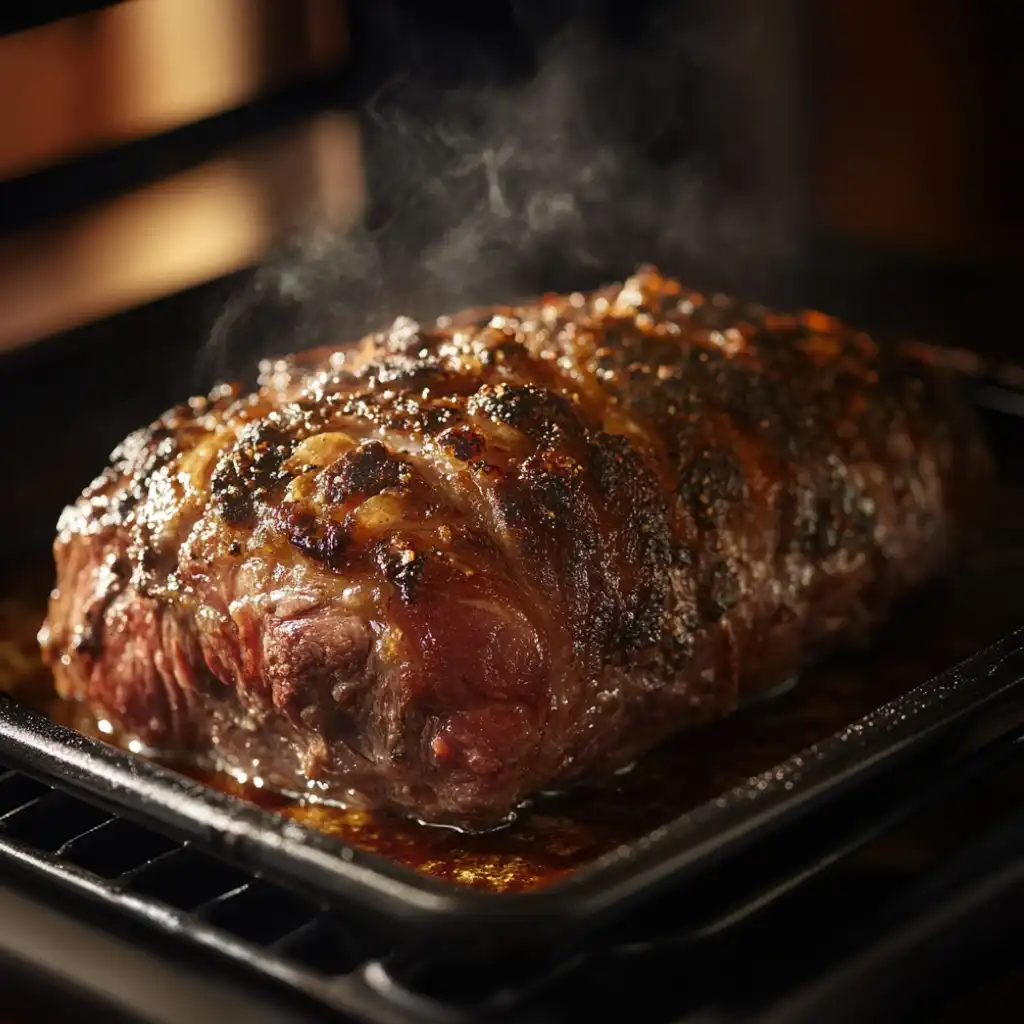
The blackened honey Dijon crust is what sets this lamb recipe apart. But achieving that deep caramelization requires understanding the science behind high-heat roasting.
The Maillard Reaction: How High Heat Enhances Flavor
When you roast meat at high temperatures, the Maillard reaction occurs. This is a chemical process where amino acids and sugars react to create deep, rich flavors and a crispy brown crust.
✔ Honey Dijon mustard in the rub helps speed up caramelization.
✔ High heat (500°F for the first 10 minutes) locks in juices.
✔ Herbs and garlic roast into the crust, adding layers of smoky complexity.
Why Searing at 500°F Creates the Perfect Crust
Starting at 500°F for 10 minutes does two things:
- It sears the outside, forming a flavorful crust.
- It traps moisture inside, preventing dry lamb.
After the sear, reducing the heat to 400°F ensures the inside cooks gently while the crust continues developing.
Achieving the Right Balance Between Crispy Exterior and Juicy Interior
The key is to monitor the internal temperature. For medium-rare, remove the lamb at 130-135°F, allowing carryover cooking to finish the job.
With this method, your Roast Leg of Lamb with Blackened Honey Dijon Crust will have a perfect golden-brown, crispy coating while remaining tender and juicy inside.
Step-by-Step Cooking Instructions

Roasting a Roast Leg of Lamb with Blackened Honey Dijon Crust may seem intimidating, but by following these steps, you’ll achieve tender, flavorful meat with a perfectly crisped crust.
Step 1: Preparing the Herb and Honey Dijon Rub
The key to a flavorful crust starts with a well-balanced rub. In a small bowl, mix:
- ¼ cup honey Dijon mustard
- 10 cloves garlic, minced
- 1 tbsp dried oregano
- 1 tbsp dried thyme
- 1 tsp dried rosemary
- 1½ tbsp kosher salt
- 2 tsp black pepper
- 1 tbsp olive oil
Coat the lamb generously, ensuring the mixture penetrates every crevice. Let it rest for at least 2 hours (or overnight) to absorb maximum flavor.
Step 2: High-Heat Searing for a Perfect Blackened Dijon Crust
A high initial temperature is crucial for creating the blackened crust. Preheat your oven to 500°F (260°C) and allow it to reach full temperature before placing the lamb inside.
Step 3: Slow-Roasting for Tender and Juicy Honey Mustard Lamb
- Place the lamb on a roasting rack over a baking tray lined with sliced onions and carrots.
- Roast at 500°F for 10 minutes to create a crisp exterior.
- Reduce the heat to 400°F and continue roasting for about 20-25 minutes per pound.
Step 4: Using a Meat Thermometer for Perfect Doneness
Insert a meat thermometer into the thickest part (without touching the bone). Remove the lamb from the oven when it reaches:
- 130-135°F for medium-rare
- 140-145°F for medium
Step 5: Resting and Carving the Lamb for the Best Texture
Resting is non-negotiable. Cover the lamb loosely with foil and let it sit for 15-20 minutes. This step locks in the juices.
To carve, slice against the grain into thin, even pieces for the most tender bite. Serve with the pan juices or an onion-based gravy.
By following these steps, you’ll get a crispy, caramelized crust with juicy, melt-in-your-mouth meat.
How to Serve and Pair Your Roast Leg of Lamb
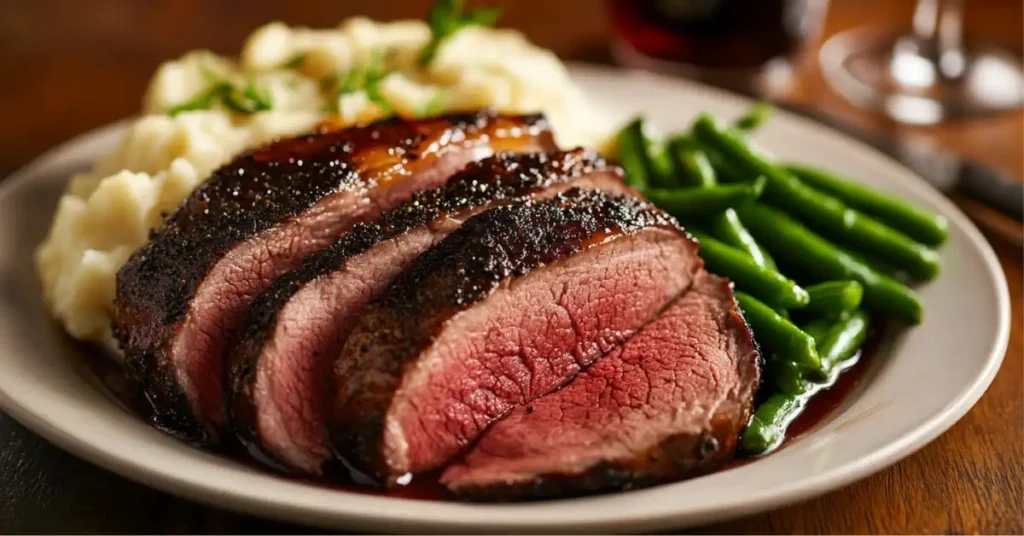
Pairing the right side dishes with Roast Leg of Lamb with Blackened Honey Dijon Crust brings out the full range of flavors. Whether you prefer classic comfort sides or Mediterranean-inspired accompaniments, there are plenty of great options.
Classic Side Dishes: Mashed Potatoes, Roasted Carrots, and Green Beans
- Creamy mashed potatoes—rich, buttery potatoes complement the bold flavors of the lamb.
- Roasted carrots—sweet caramelized carrots balance the tangy Dijon crust.
- Sautéed green beans—adds a fresh, crisp contrast to the savory lamb.
Fresh Mediterranean-Inspired Sides: Greek Salad, Tzatziki, and Couscous
- Greek salad—cucumbers, tomatoes, feta, and olives bring a light, refreshing element.
- Tzatziki sauce—a cool, garlicky yogurt dip that pairs perfectly with lamb.
- Lemon-infused couscous—fluffy grains with a citrus kick enhance the meal’s brightness.
With the perfect sides and a great wine pairing, your Roast Leg of Lamb with Blackened Honey Dijon Crust will be a well-rounded, unforgettable meal.
How to Store, Freeze, and Reheat Leftovers

Even though Roast Leg of Lamb with Blackened Honey Dijon Crust is best enjoyed fresh, proper storage ensures you can savor it later without losing flavor or tenderness.
Best Practices for Storing Leftover Lamb in the Refrigerator
- Allow the lamb to cool completely before storing to prevent moisture buildup.
- Wrap it tightly in aluminum foil or place it in an airtight container to maintain freshness.
- Store in the fridge for up to 3-4 days.
For sliced lamb, add a small amount of broth to the container to prevent drying out.
How to Freeze Lamb for Future Meals
Freezing is a great way to extend the life of your roasted lamb. Here’s how to do it right:
- Slice the lamb into portions for easy reheating.
- Wrap each portion tightly in plastic wrap, then place them in a freezer-safe bag.
- Label with the date and store in the freezer for up to 3 months.
Reheating Methods That Preserve Moisture and Flavor
- Oven: Preheat to 325°F, wrap lamb in foil, and heat for 15-20 minutes.
- Stovetop: Sauté slices over low heat with a splash of broth for a quick warm-up.
- Microwave: Use short intervals at 50% power to prevent overcooking.
By following these storage and reheating methods, your lamb will stay juicy, flavorful, and just as delicious as when it was first cooked.
Answering Common Questions About Roast Leg of Lamb
Cooking Roast Leg of Lamb with Blackened Honey Dijon Crust can raise some common questions, especially if you’re making it for the first time. Let’s address some key concerns.
How Long Should I Cook a Leg of Lamb Per Pound?
The general rule is 20-25 minutes per pound at 400°F after an initial 10-minute sear at 500°F. Always check with a meat thermometer:
- 130-135°F for medium-rare
- 140-145°F for medium
Should I Cover My Lamb While Roasting?
No, roasting uncovered allows the blackened honey Dijon crust to caramelize and develop its signature crispy texture. However, if the crust browns too quickly, tent it loosely with foil.
Can I Use Different Mustard Variants?
Yes! While honey Dijon mustard adds the perfect balance of tang and sweetness, you can substitute:
- Spicy brown mustard for a bolder flavor.
- Whole grain mustard for a more rustic texture.
What’s the Best Way to Prevent Overcooking?
Using a meat thermometer is key. Remove the lamb from the oven 5°F before your target doneness since it will continue cooking as it rests.
How Can I Make This Recipe Keto or Low-Carb Friendly?
Simply swap honey Dijon mustard for Dijon mustard mixed with a sugar-free sweetener like monk fruit or stevia.
By following these tips, you’ll master the art of cooking Roast Leg of Lamb with Blackened Honey Dijon Crust with confidence.
Conclusion and Final Thoughts
A beautifully roasted leg of lamb is more than just a meal; it’s an experience. The combination of honey Dijon mustard, garlic, and herbs creates a perfectly balanced crust that enhances the lamb’s natural flavors. With a crispy, caramelized exterior and a tender, juicy interior, this dish is guaranteed to impress.
Key Takeaways for the Best Roast Leg of Lamb:
✔ Choose high-quality lamb for the best flavor and tenderness.
✔ Let the honey Dijon rub marinate the meat for deeper taste.
✔ Start with a high-temperature sear (500°F) to develop that rich crust.
✔ Use a meat thermometer to ensure perfect doneness.
✔ Let the lamb rest before slicing to lock in its juices.
Whether you’re making this for a holiday gathering, special dinner, or Sunday feast, this flavor-packed recipe will be a standout. Pair it with classic or Mediterranean-inspired sides, and you have a meal fit for any occasion.
If you love rich, flavorful roasts, you might also enjoy our guide on How to Cook the Perfect Venison Roast. It’s packed with tips for achieving tender, juicy meat every time!
For a quicker but equally flavorful option, check out our Bone-In Shank Pressure Cooker Recipes perfect for fall-off-the-bone tenderness in less time!
Now that you’re armed with everything you need to know, it’s time to get cooking! Try this Roast Leg of Lamb with Blackened Honey Dijon Crust and enjoy every tender, flavorful bite.

